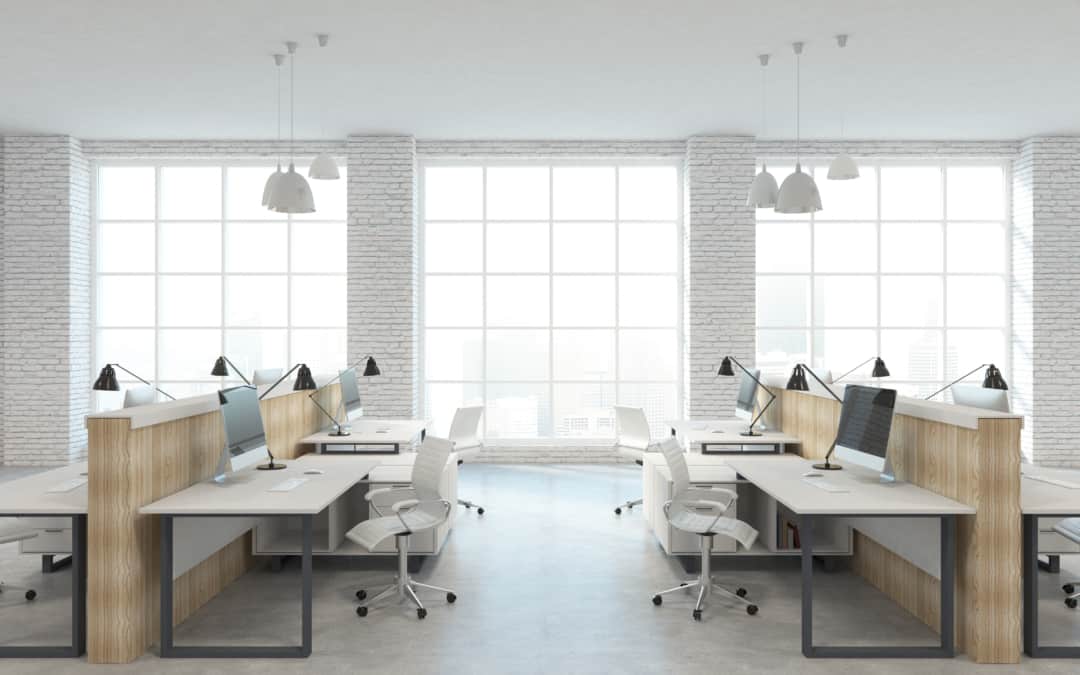Modular Office Design & Furniture Considerations for the Modern Flexible Hybrid Office
Modular office furniture has been around since the early 20th century, but became increasingly popular in the 1960s and 1970s due to changes in workplace culture and technology. During this time period, office spaces began to shift from traditional, hierarchical layouts to more open, collaborative environments. This new approach to office design required furniture that was more flexible and adaptable, which led to a rise in the popularity of modular furniture.
Advances in technology during the 1960s and 1970s allowed for the mass production of modular furniture, making it more affordable and accessible for businesses of all sizes. Availability and affordability further increased the popularity of modular furniture as businesses began to recognize the benefits of its flexibility and versatility.
Today, modular office furniture continues to be a popular choice for businesses of all sizes and industries. The pandemic’s impact on the workplace and the increasingly popular hybrid-remote approach to office design have combined to make flexibility of the utmost importance. As modular furniture can adapt, it is an attractive option for businesses that prioritize collaboration, innovation, and flexibility in their workspaces.
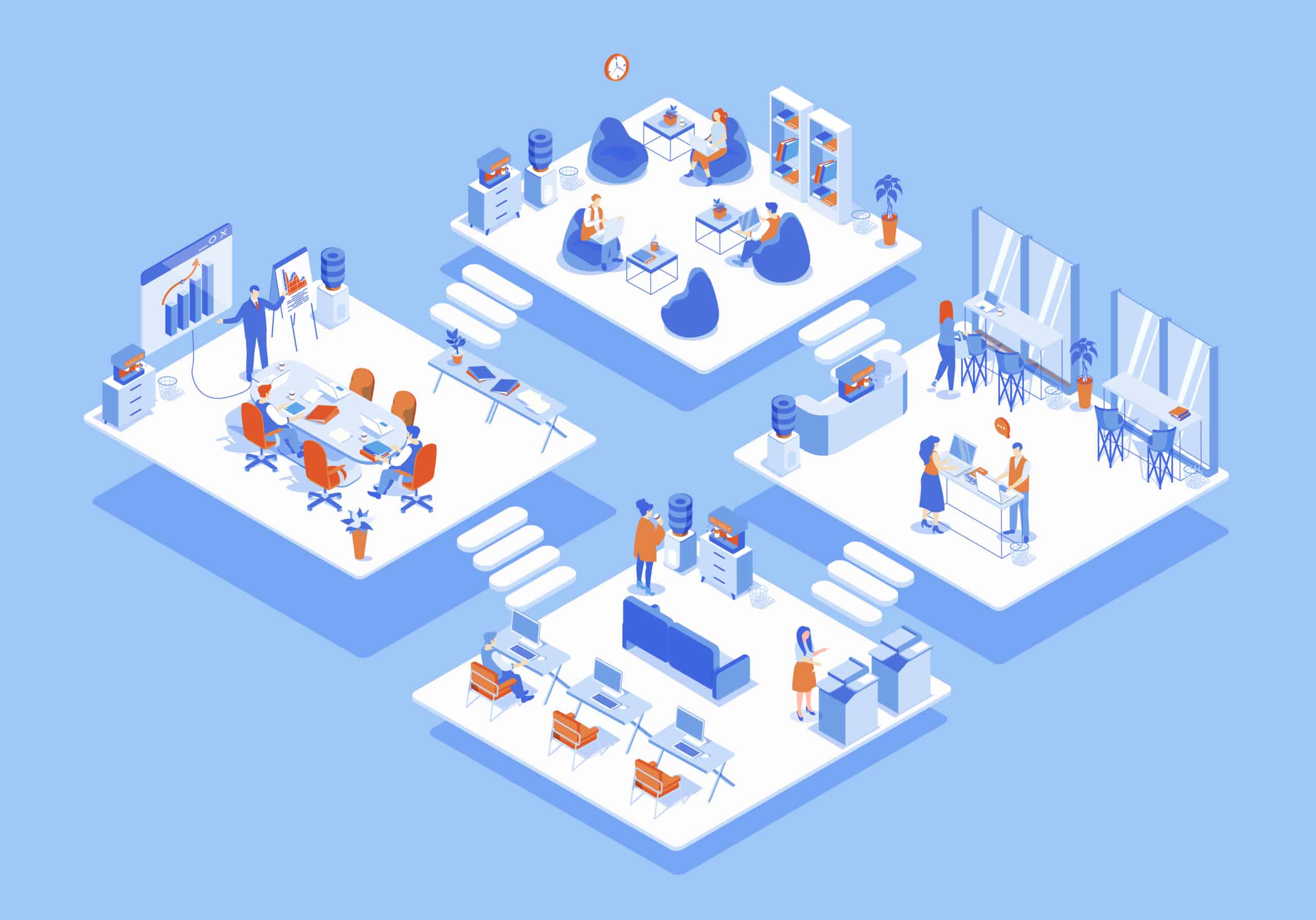
What is modular office design?
Modular office design is an approach that uses pre-fabricated components or modules to create flexible and adaptable workspaces. Modules/components can include modular office furniture systems as well as items that form walls or rooms. This approach to office design allows for the easy reconfiguration of office layouts and the addition or removal of components as needed.
Modular office design can be employed with two different aims: 1) the ability to change the overall office interior layout (think: modular walls) as well as furniture or 2) a consistent office interior layout, but the ability to change how the furniture is arranged.
Fully modular office designs are typically made up of standardized panels, walls, ceilings, and floors that can be assembled and disassembled to create a variety of layouts. This approach is rare, as most offices do not moving wall panels around to rearrange an entire office layout completely. More often, the overall interior structure remains consistent while changes are made to the furniture to adapt to the number of employees or to how people are using the office and furnishings. With an open office layout, more layout flexibility can be achieved by rearranging modular furniture.
Modular office design strategies can be utilized to create private offices, open-plan workspaces, meeting rooms, and other work environments. These strategies can also be used in temporary office spaces, such as construction sites or disaster-recovery centers. When employed properly, a modular office design strategy can be a cost-effective solution for many businesses looking for flexibility.
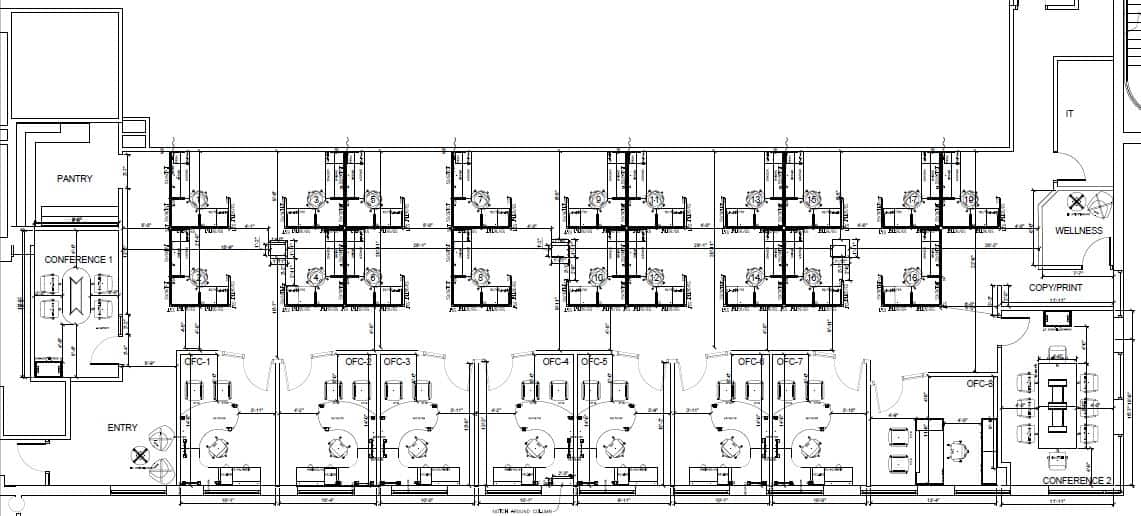
Modular Office Design
Modular office furniture for flexible office design
Modular office furniture can help solve challenges that many businesses are facing in today’s hybrid remote workplace by adding valuable flexibility to an office’s design. Different types of modular office furniture help create a flexible modular office design, offering easy customization and reconfiguration of the office space. Businesses are able to adapt to changing needs and maximize the use of space, leading to increased productivity and efficiency. Here are some of the most popular types of modular office furniture:
- Modular desks
- Modular workstations
- Modular cubicles
- Modular benching
- Modular storage units and shelving
- Partition walls
- Modular seating
- Modular tables
Modular Desks
Modular desks are versatile and flexible, designed to be reconfigured or adjusted easily to fit the needs of modern office spaces. They can be customized, reconfigured, or adjusted as needed and are typically comprised of interchangeable components, including tabletops, legs, drawers, and other accessories, that can be assembled and disassembled to create a customized workspace. Several different types of modular desks are available, each with its own unique features and benefits. Here are a few examples:
Panel-based modular desks: These desks are constructed using panels that can be reconfigured easily to create different desk configurations. They often feature accessories like filing cabinets, shelving, and other storage options.
Bench-based modular desks: These desks are designed with long, continuous work surfaces that can be used by multiple employees at the same time. They are often used in open-office environments where collaboration is encouraged.
Height-adjustable modular desks: These desks can be adjusted to different heights to accommodate different work styles and preferences. They are often used in ergonomic office designs to promote better posture and reduce the risk of injury.
Mobile modular desks: These desks are designed to be moved around the office easily and as needed. They often feature casters or wheels for mobility and may include foldable or collapsible components to make them more compact for storage.
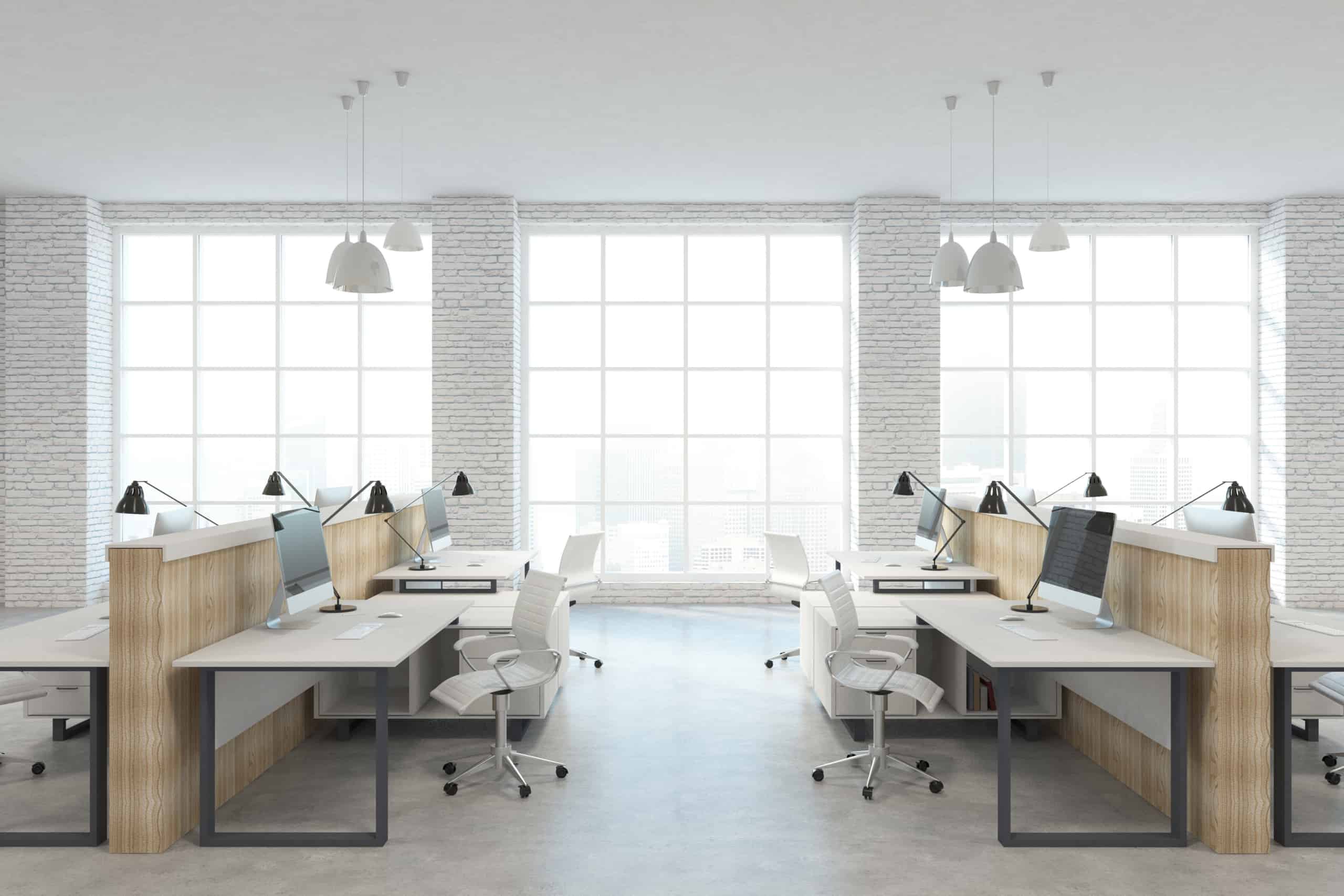
Modular Office Desks
Modular Workstations
Modular workstations are versatile workspaces that can accommodate either a single person or multiple people together on a single piece of interconnected office furniture. Modular workstations offer businesses a wide range of flexible workspace-configuration options that meet the unique needs of employees. In the modern office that utilizes a hybrid remote model, the number of employees in the office may change often. In that scenario, modular workstations that can be adjusted for how many workspaces are needed in certain areas of the office are valuable. Different types of modular workstations and how they can be used:
Bench-style workstations: Bench-style workstations consist of a long table with multiple workstations arranged in a row. These workstations are ideal for businesses that prioritize collaboration and communication among their employees, as they encourage teamwork and easy communication between colleagues.
Cubicle workstations: Cubicle workstations consist of enclosed workspaces that provide employees with privacy and minimize distractions. These workstations are ideal for businesses that require their employees to focus on individual tasks and projects, such as those in the accounting, legal, or finance industries.
Height-adjustable workstations: Height-adjustable workstations allow employees to adjust the height of their desk or table to suit their individual needs. This type of workstation is ideal for businesses that prioritize employee health and well-being, as it allows employees to switch between standing and sitting positions throughout the day.
Panel-based workstations: Panel-based workstations consist of modular panels that can be easily reconfigured to create a workspace that meets the specific needs of the business. These workstations are ideal for businesses that require a flexible and adaptable workspace that can be easily modified to meet changing needs.
Collaborative workstations: Collaborative workstations consist of open tables with shared workspaces that encourage collaboration and teamwork among employees. These workstations are ideal for businesses that prioritize communication and creativity among their employees, such as those in the marketing, design, or technology industries.

Modular Workstations
What is the difference between a modular desk and a modular workstation?
A modular desk typically refers to a single workspace while a modular workstation can refer to a larger workspace that is designed to accommodate multiple users at the same time. Workstations are often made up of a series of interconnected desks, panels, and storage units that can be easily reconfigured to create different office layouts. They are often used in larger offices or in open-plan work environments where collaboration and teamwork are important.
Modular Cubicles
A modular cubicle is a type of workspace that is made up of interconnected panels, which can be easily reconfigured to create different layouts and configurations. It’s a popular option for many types of office environment, and particularly useful for businesses that currently require more flexibility. Modular cubicles are adaptable, allowing businesses to reconfigure their office layouts easily and as needed to meet changing workforce needs, maximize the use of space, and accommodate a varying number of in-office employees. Panels can be made from a variety of materials, such as glass, fabric, or laminate, and can be customized with features that include doors, windows, or built-in storage.
Here are some examples of modular cubicles and how they can be used:
Open-plan cubicles: These are cubicles that are designed to promote collaboration and teamwork. They typically feature low panels that allow employees to see and communicate with each other easily, but still provide some level of privacy and sound insulation.
Private cubicles: These are cubicles that are designed for individual work and privacy. They often feature higher panels that provide more sound insulation and visual privacy.
Modular call-center cubicles: These cubicles are designed specifically for call centers and other customer-service environments. Typically, of a more minimalist design, call-center cubicles are simple in order to accommodate a hot-desking approach where a workstation is often not assigned to a single employee.
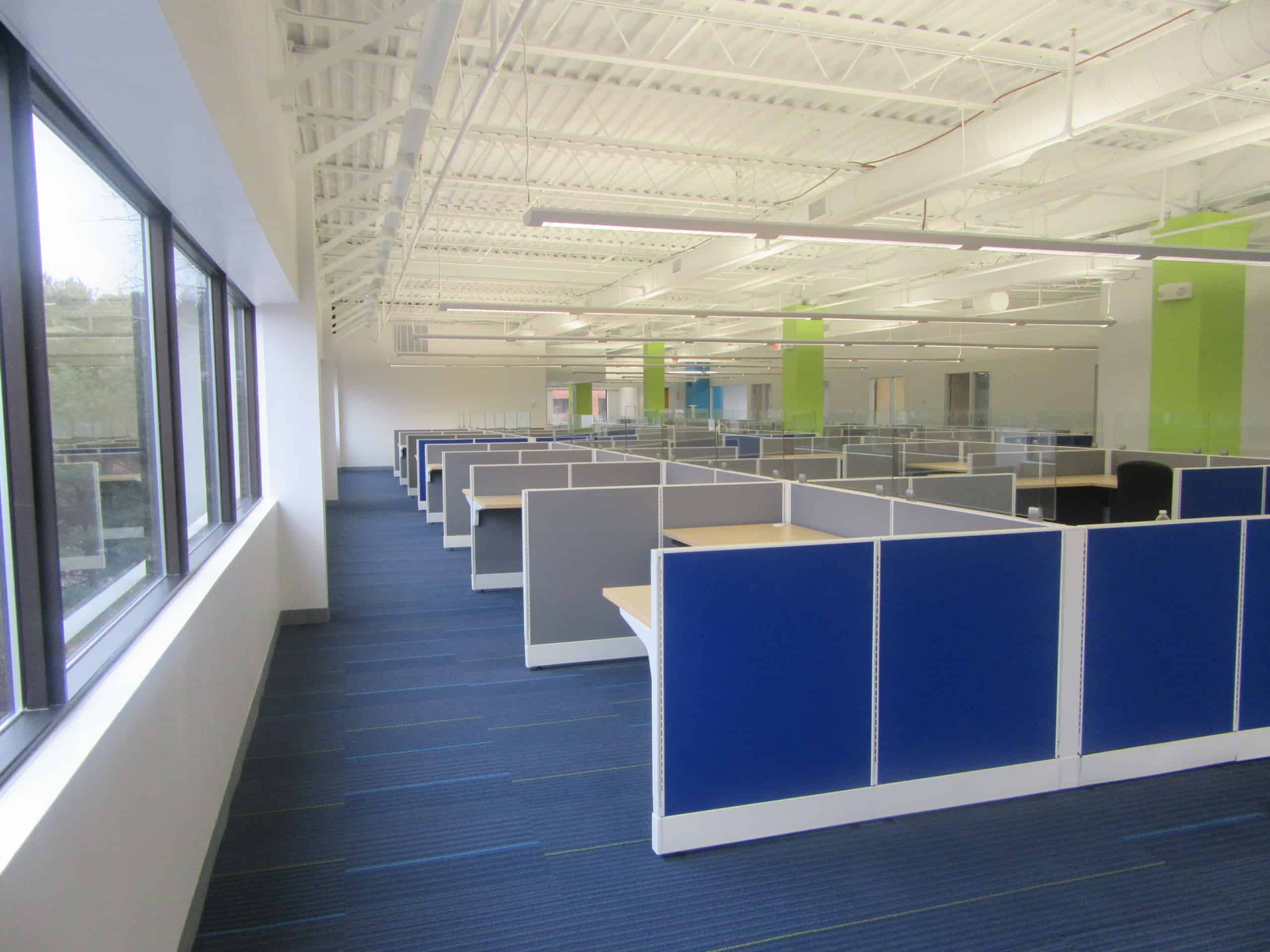
Modular Office Cubicles
Modular Office Benching
Modular office benching is office furniture designed to accommodate multiple employees in a shared workspace. These workstations typically consist of long, continuous work surfaces, often with shared storage and other accessories. They are often used in open-plan office environments to promote collaboration and teamwork. The configuration of modular office benching can vary depending on the specific needs of the office and the available space. Here are some common configurations for modular office benching:
Straight benching: This is the most basic configuration, where multiple desks are placed in a straight line, usually facing a common wall. This configuration is suitable for small-to-medium-sized offices where space is limited.
L-shaped benching: In this configuration, desks are arranged in an L-shape, usually with one desk perpendicular to the others. This configuration is ideal for creating designated workspaces, providing enough room for computers and other necessary equipment.
U-shaped benching: In this configuration, desks are arranged in a U-shape, usually with a shared workspace in the center. U-shaped benching provides ample space for each employee and promotes collaboration among team members.
Clustered benching: In this configuration, several smaller workstations are clustered together to form a larger workspace. It is an ideal configuration for small teams that require a degree of privacy but still encourage collaboration.
Floating benching: This is a flexible configuration where desks are arranged more organically rather than being anchored to a specific location. This configuration is ideal for collaborative work environments where workers need to move around freely and work together on different projects.
Multi-level benching: In this configuration, desks are arranged on different levels, providing employee privacy and creating a visually interesting workspace. This configuration is suitable for larger offices with ample space where workers must be able to concentrate without distraction.
What happens when one benching configuration is no longer working? How does an office change how the modular benching is used? Here are ways to leverage the flexibility of modular bench workstations:
- Change the layout – One of the simplest ways to reconfigure modular office benching is to change the layout of the workstations. Rearrange the individual components, such as the work surfaces, dividers, and storage units, to create a different arrangement that better suits the needs of the employees.
- Add or remove dividers – Modular office benching often includes dividers that provide a level of privacy and separation between employees. Adding or removing these dividers can create a different level of privacy and interaction between employees.
- Customize the work surfaces – Modular office benching work surfaces can be customized with different finishes, sizes, and features, like built-in power outlets and cable management. Changing the work surface configurations can create a workspace that better suits the specific needs of employees.
- Add or remove storage – Modular office benching often includes shared storage options, such as file cabinets or overhead storage units. Adding or removing these storage options can create more or less storage space for each employee.
- Incorporate height-adjustable desks – Height-adjustable desks create a more ergonomic workspace that can be adjusted to the needs of each employee. Incorporating height-adjustable desks into modular office benching can create a workspace that promotes comfort and productivity.

Modular Office Benching
Partition Walls
Partition walls can be used to divide office space into different areas. Modular partition walls are typically designed to be assembled and disassembled easily, making it simple to create different office configurations as needed. They can also be fitted with features like doors, windows, or built-in storage to customize the office space further. In an office that offers a hybrid remote schedule, more employees may be present some days than other days. Partition walls allow teams to collaborate and they create separation from other teams to minimize distractions. They can also help provide more isolation for social distancing.
Mobile Storage Units
Mobile storage units can be moved around the office easily and as needed. They are often modular in design, with interchangeable shelves or drawers that can be adjusted or removed to create different storage configurations. This increased flexibility within the office layout helps maximize the use of space. In a hybrid remote scenario, employees may not have dedicated workstations; modular storage options can provide employees space to keep store belongings that is not in the way and does not cause clutter.
Break-out and Collaboration Areas
Modular office furniture is often used for break-out and collaboration areas in modern workplaces. These areas are designed to provide space where employees can take a break from work, collaborate with colleagues, and recharge their energy. Modular office furniture is a terrific option for break-out and collaboration areas because it allows businesses to create a flexible and adaptable space that can be reconfigured easily and as needed. Flexibility is key in the modern office where hybrid remote schedules may include a full office some days and a more-empty office other days. To accommodate variable attendance, businesses may need certain areas to be multi-use. On busier days, the break-out area may need to be used for workspace. Here are some ways that modular office furniture can be used for break-out and collaboration areas:
Modular lounge seating: Modular lounge seating is a popular choice for break-out and collaboration areas. These seating systems consist of individual pieces that can be rearranged easily to create different configurations, depending on how the space is needed. They can also be upholstered in a wide range of fabrics and colors; businesses can customize the look of their lounge seating to suit their brand and design preferences.
Collaborative tables: Collaborative tables are another popular choice for break-out and collaboration areas. These tables are designed to accommodate multiple people and often feature built-in power outlets and other amenities that make them ideal for collaborative work. Collaborative tables can also be used for team lunches.
Mobile whiteboards: Mobile whiteboards allow employees to brainstorm and collaborate in a more visual way in break-out and collaboration areas. Whiteboards can be moved around the space easily.
Privacy screens: Privacy screens are another important element in break-out and collaboration areas. They can create a more private and intimate space where employees can work and be less of a distraction to nearby coworkers. These screens can be made from a variety of materials, including fabric or glass, and can be customized to match the overall design of the space.
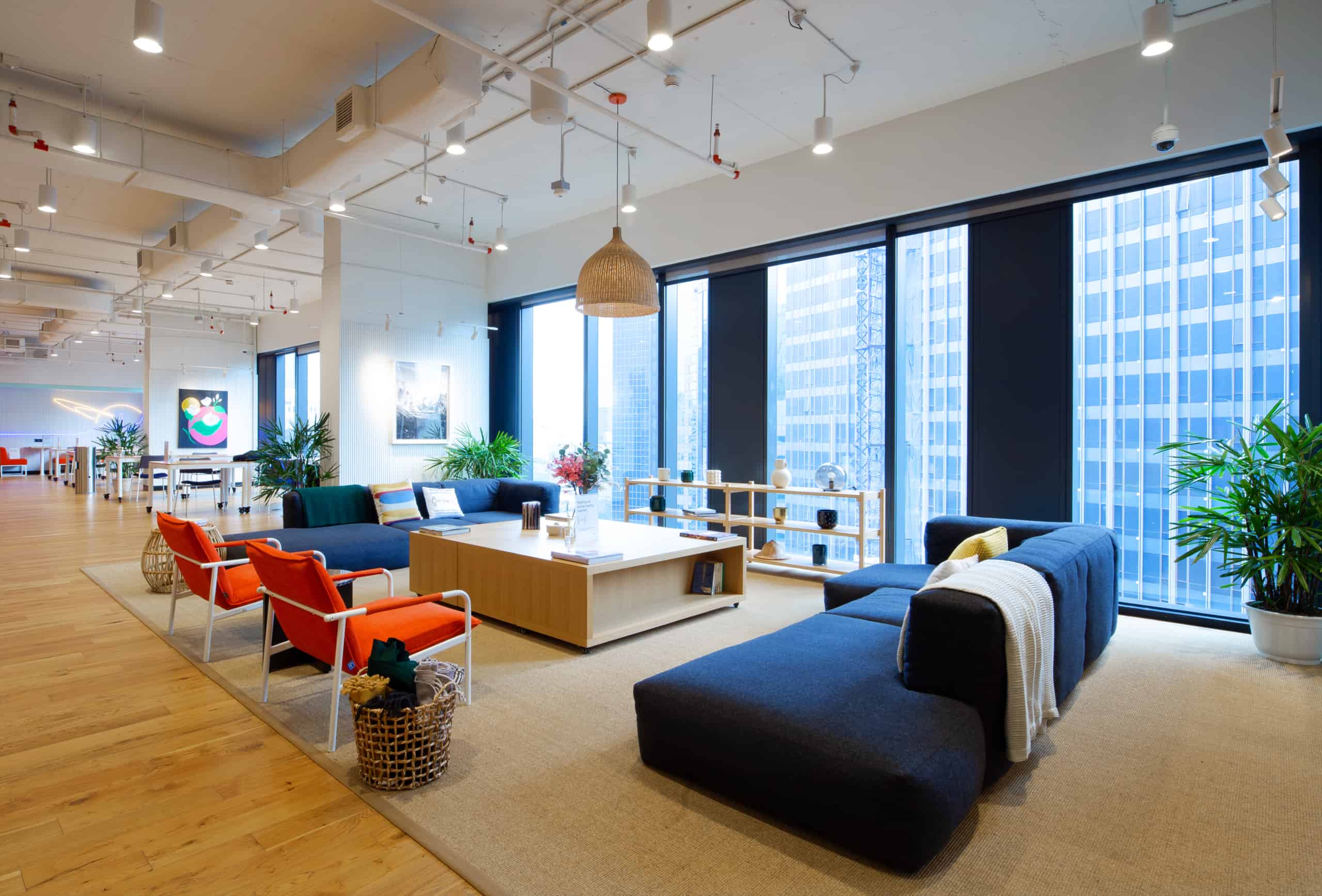
Modular Collaboration Area
Modular office furniture in lounge areas
Modular office furniture is often used in lounge areas within offices to create a comfortable and flexible space where employees can relax and collaborate. With modular office furniture, businesses can create spaces that can be reconfigured easily and as needed. Flexibility within a lounge space encourages socialization and collaboration, while also providing comfortable and welcoming space where employees can take a break from work. Just as with break-out and collaboration areas, the modern office may not have the space for a dedicated lounge area. When a multi-purpose area is used as a lounge area, modular furniture provides the needed flexibility to adjust the space from one use to another.
How do hybrid offices use modular furniture?
The hybrid office is one of the biggest trends to impact office design and office furniture in several decades. Hybrid-office models combine remote work with in-person work. They often use modular furniture to create flexible and adaptable workspaces that can accommodate the changing needs of employees and businesses.
Businesses are challenged when they still need office space although the space is not being used as fully or as consistently as before. When employees come into the office on the same days in order to collaborate, offices need just as many, or almost as many, workstations as they did before the hybrid-remote trend started. If employees are using the office less, you may think that a business could save money by downsizing, but that is proving to be wishful thinking. If businesses want to reduce office square footage and costs, they will need to get creative about how the office is designed and how furniture is used. Learn more about some office design trends for 2023.

